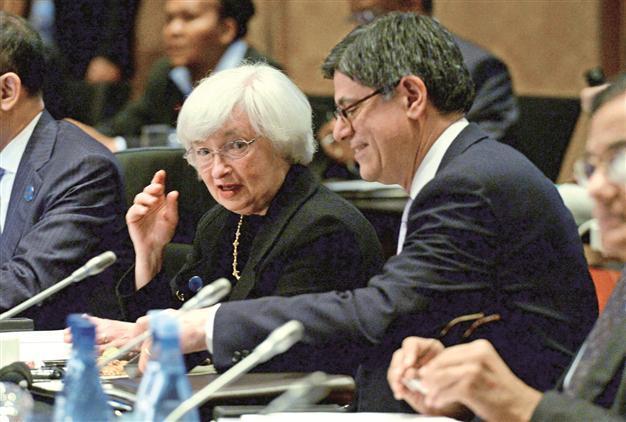Fed Chair Yellen to stick to game plan on taperin
WASHINGTON - Agence France-Presse

Federal Reserve chief Yellen (L) chats with Treasury Secretary Jacob Lew before the G20 Finance Ministers and Central Bank Governors meeting in this February photo. Yellen will face media on March 19. REUTERS photo
New Federal Reserve chief Janet Yellen is expected to stick to the game plan when she chairs her first monetary policy meeting this week, further cutting back economic stimulus.But, six weeks after inheriting Ben Bernanke’s mantle, she is also under the gun to make a pivot in the way the Fed has been signaling its intentions. Handled well, that delicate shift in how the Fed foreshadows an eventual rate hike could assuage markets. But communicated badly, it could result in volatile movements and leave the new Fed chief on the back foot.
The first meeting under Yellen’s lead of the Federal Open Market Committee (FOMC), on March 18-19, is expected to conclude that unusually harsh winter storms were mainly behind the slowdown in economic activity in December to February. Despite a series of weak job creation numbers, slow construction activity and slow retail sales since December, most analysts expect the FOMC won’t pause in the drawdown of its bond buying program, its huge easy-money the stimulus effort.
The Fed has cut the program by $20 billion to $65 billion a month since the beginning of the year, and another $10 billion cut could be decided this week. Yellen already showed her bias toward the weather explanation when she testified to the U.S. Senate on Feb. 27.
Cold played some role
Taking note of the poor data, she said she “wouldn’t want to jump to conclusions.”
However, she added, “It is clear that unseasonably cold weather has played some role.” A week later, the Fed Beige Book survey of regional economies, important content for the FOMC policy meeting, mentioned the weather 119 times in explaining sluggish activity in much of the country.
A modest rebound in retail sales data in February suggested that there is some pent-up demand, and analysts hope this month and next will show a rebound in the economy. “We expect catch-up in March, leading to good momentum heading in to the second quarter,” said Jim O’Sullivan at High Frequency Economics. Yellen, who has always stayed behind the scenes during her three years as Bernanke’s deputy, will face the media on March 19 when she announces the FOMC’s policy decision.
With the bond-buying taper expected to remain on track, the challenge will be to explain how the FOMC will adjust the communication of its expectations: essentially, how it signals to the market when it plans to begin raising its key interest rate, held at a rock-bottom 0-0.25 percent since December 2008.
At the end of 2012, the FOMC set specific thresholds for when it could begin lifting the rate: 2.0 percent for inflation and a 6.5 percent unemployment rate. Most policymakers did not think those levels would be breached until 2015, and the current Fed outlook for a rate hike is later next year.
Inflation is still very low, but the unemployment rate has fallen faster than expected, now at 6.7 percent, and is bumping against the threshold. Yellen and other Fed officials say that does not reflect real problems in the jobs market, including high part-time work, a large number of market dropouts and a large number of long-term unemployed.
For that reason, said Deutsche Bank economist Joseph LaVorgna, the FOMC is likely to change its forward guidance “by switching from a quantitative to qualitative approach, meaning the number thresholds on the unemployment rate and inflation will be abandoned.”
















